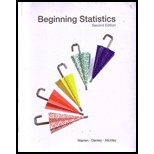
a.
To find:
Effect on margin of error for confidence interval for a population
Answer to Problem 22E
Solution:
When the sample size decreases, there is an increase in the margin of error for a population mean.
Explanation of Solution
Given:
The sample size decreases from
Description:
Given a population with standard deviation
The true population parameters probability lies in this interval range is known as the confidence level
At a certain level of confidence, the interval in which the maximum error can be observed is known as the confidence interval.
The maximum distance from point estimate that the confidence interval covers is margin of error and is given by:
where,
Calculation:
Thus, the ratio of margins of error is:
where
The ratio is calculated as follows:
which gives:
Conclusion:
When the sample size decreases, there is an increase in the margin of error for a population mean.
b.
To find:
Effect on width of confidence interval for a population mean if sample size decreases from 500 to 387 people.
Answer to Problem 22E
Solution:
When the sample size decreases, there is an increase in the width of confidence interval for a population mean.
Explanation of Solution
Given:
The sample size decreases from
Description:
Given a population with standard deviation
The true population parameters probability lies in this interval range is known as the confidence level
At a certain level of confidence, the interval in which the maximum error can be observed is known as the confidence interval.
The maximum distance from point estimate that the confidence interval covers is margin of error and is given by:
where,
Given the sample mean
and width of confidence interval is:
Calculation:
Thus, the ratio of widths of respective confidence intervals is:
where
The ratio is calculated as follows:
which gives:
Conclusion:
When the sample size decreases, there is an increase in the width of confidence interval for a population mean.
Want to see more full solutions like this?
Chapter 8 Solutions
Beginning Statistics, 2nd Edition
- A company found that the daily sales revenue of its flagship product follows a normal distribution with a mean of $4500 and a standard deviation of $450. The company defines a "high-sales day" that is, any day with sales exceeding $4800. please provide a step by step on how to get the answers in excel Q: What percentage of days can the company expect to have "high-sales days" or sales greater than $4800? Q: What is the sales revenue threshold for the bottom 10% of days? (please note that 10% refers to the probability/area under bell curve towards the lower tail of bell curve) Provide answers in the yellow cellsarrow_forwardFind the critical value for a left-tailed test using the F distribution with a 0.025, degrees of freedom in the numerator=12, and degrees of freedom in the denominator = 50. A portion of the table of critical values of the F-distribution is provided. Click the icon to view the partial table of critical values of the F-distribution. What is the critical value? (Round to two decimal places as needed.)arrow_forwardA retail store manager claims that the average daily sales of the store are $1,500. You aim to test whether the actual average daily sales differ significantly from this claimed value. You can provide your answer by inserting a text box and the answer must include: Null hypothesis, Alternative hypothesis, Show answer (output table/summary table), and Conclusion based on the P value. Showing the calculation is a must. If calculation is missing,so please provide a step by step on the answers Numerical answers in the yellow cellsarrow_forward
 MATLAB: An Introduction with ApplicationsStatisticsISBN:9781119256830Author:Amos GilatPublisher:John Wiley & Sons Inc
MATLAB: An Introduction with ApplicationsStatisticsISBN:9781119256830Author:Amos GilatPublisher:John Wiley & Sons Inc Probability and Statistics for Engineering and th...StatisticsISBN:9781305251809Author:Jay L. DevorePublisher:Cengage Learning
Probability and Statistics for Engineering and th...StatisticsISBN:9781305251809Author:Jay L. DevorePublisher:Cengage Learning Statistics for The Behavioral Sciences (MindTap C...StatisticsISBN:9781305504912Author:Frederick J Gravetter, Larry B. WallnauPublisher:Cengage Learning
Statistics for The Behavioral Sciences (MindTap C...StatisticsISBN:9781305504912Author:Frederick J Gravetter, Larry B. WallnauPublisher:Cengage Learning Elementary Statistics: Picturing the World (7th E...StatisticsISBN:9780134683416Author:Ron Larson, Betsy FarberPublisher:PEARSON
Elementary Statistics: Picturing the World (7th E...StatisticsISBN:9780134683416Author:Ron Larson, Betsy FarberPublisher:PEARSON The Basic Practice of StatisticsStatisticsISBN:9781319042578Author:David S. Moore, William I. Notz, Michael A. FlignerPublisher:W. H. Freeman
The Basic Practice of StatisticsStatisticsISBN:9781319042578Author:David S. Moore, William I. Notz, Michael A. FlignerPublisher:W. H. Freeman Introduction to the Practice of StatisticsStatisticsISBN:9781319013387Author:David S. Moore, George P. McCabe, Bruce A. CraigPublisher:W. H. Freeman
Introduction to the Practice of StatisticsStatisticsISBN:9781319013387Author:David S. Moore, George P. McCabe, Bruce A. CraigPublisher:W. H. Freeman





